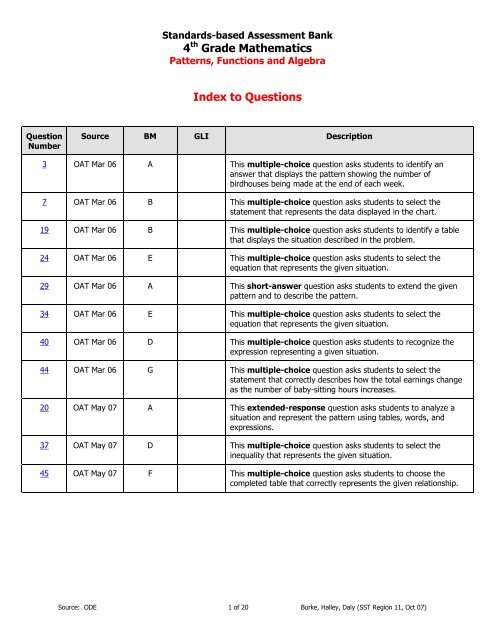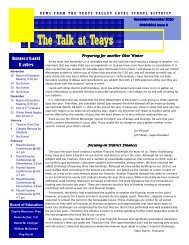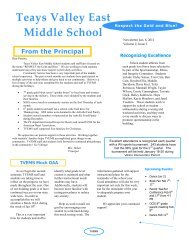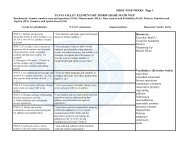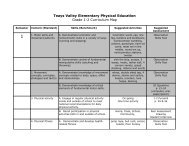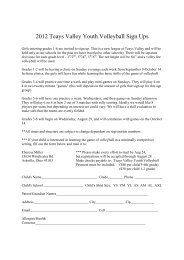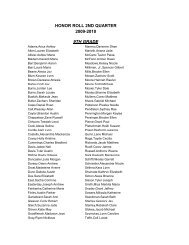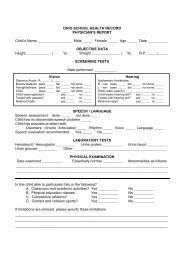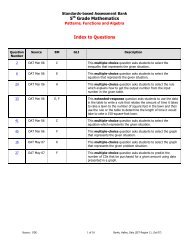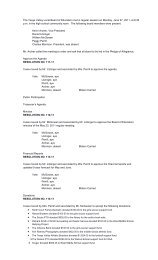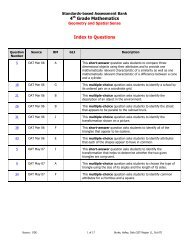Patterns, Functions & Algebra
Patterns, Functions & Algebra
Patterns, Functions & Algebra
Create successful ePaper yourself
Turn your PDF publications into a flip-book with our unique Google optimized e-Paper software.
Standards-based Assessment Bank<br />
4 th Grade Mathematics<br />
<strong>Patterns</strong>, <strong>Functions</strong> and <strong>Algebra</strong><br />
Index to Questions<br />
Question<br />
Number<br />
Source BM GLI Description<br />
3 OAT Mar 06 A This multiple-choice question asks students to identify an<br />
answer that displays the pattern showing the number of<br />
birdhouses being made at the end of each week.<br />
7 OAT Mar 06 B This multiple-choice question asks students to select the<br />
statement that represents the data displayed in the chart.<br />
19 OAT Mar 06 B This multiple-choice question asks students to identify a table<br />
that displays the situation described in the problem.<br />
24 OAT Mar 06 E This multiple-choice question asks students to select the<br />
equation that represents the given situation.<br />
29 OAT Mar 06 A This short-answer question asks students to extend the given<br />
pattern and to describe the pattern.<br />
34 OAT Mar 06 E This multiple-choice question asks students to select the<br />
equation that represents the given situation.<br />
40 OAT Mar 06 D This multiple-choice question asks students to recognize the<br />
expression representing a given situation.<br />
44 OAT Mar 06 G This multiple-choice question asks students to select the<br />
statement that correctly describes how the total earnings change<br />
as the number of baby-sitting hours increases.<br />
20 OAT May 07 A This extended-response question asks students to analyze a<br />
situation and represent the pattern using tables, words, and<br />
expressions.<br />
37 OAT May 07 D This multiple-choice question asks students to select the<br />
inequality that represents the given situation.<br />
45 OAT May 07 F This multiple-choice question asks students to choose the<br />
completed table that correctly represents the given relationship.<br />
Source: ODE 1 of 20 Burke, Halley, Daly (SST Region 11, Oct 07)
Standards-based Assessment Bank<br />
4 th Grade Mathematics<br />
<strong>Patterns</strong>, <strong>Functions</strong> and <strong>Algebra</strong><br />
Benchmark:<br />
A<br />
Analyze and extend patterns, and describe the rule in words.<br />
GLI:<br />
Multiple Choice Question:<br />
3. Courtney starts with 12 birdhouses. She makes three new birdhouses each week.<br />
Which pattern shows the number of birdhouses Courtney has at the end of the each<br />
week?<br />
A. 3, 6, 9, 12<br />
B. 3, 15, 27, 39<br />
C. 12, 15, 18, 21<br />
D. 12, 24, 36, 48<br />
Commentary:<br />
This multiple-choice question asks students to identify an answer that displays the pattern<br />
showing the number of birdhouses being made at the end of each week. Answer choice C is the<br />
correct answer because the pattern starts at 12 and each following number is the sum of 3 and<br />
the previous number, such as 12 + 3 = 15, 15 + 3 = 18, 18 + 3 = 21. Answer choice A is<br />
incorrect because it starts with 3 instead of 12 and adds 3 each time. Answer choice B is also<br />
incorrect because it starts with 3 instead of 12 and adds 12 instead of 3 each time. Answer<br />
choice D is incorrect because it starts with 12 and adds 12 instead of 3 each time.<br />
The complexity level of this question is Moderate Complexity. Students are asked to create and<br />
extend a pattern.<br />
Performance Data:<br />
The percent of public school students selecting answer choice C for question 3 on the March<br />
2006 Grade 4 Achievement Test was 69%.<br />
Keywords: algebra, pattern<br />
Source: ODE 2 of 20 Burke, Halley, Daly (SST Region 11, Oct 07)
Standards-based Assessment Bank<br />
4 th Grade Mathematics<br />
<strong>Patterns</strong>, <strong>Functions</strong> and <strong>Algebra</strong><br />
Benchmark:<br />
B<br />
Use patterns to make predictions, identify relationships, and solve problems.<br />
GLI:<br />
Multiple Choice Question:<br />
7. Lyn and Kris were picking up pine cones. Every 15 minutes they counted to check the total<br />
number of pine cones they had picked up. The chart shows their results.<br />
Which statement is true according to the data in the chart?<br />
A. Kris always picked up 8 more pine cones than Lyn.<br />
B. Kris and Lyn picked up the same number of pine cones every 15 minutes.<br />
C. Kris picked up fewer pine cones than Lyn.<br />
D. Kris picked up twice as many pine cones as Lyn.<br />
Commentary:<br />
This multiple-choice question asks students to select the statement that represents the data<br />
displayed in the chart. Answer choice D is the correct answer because the number of pine<br />
cones Kris picked at the end of each 15 minute period is two times the number of pine cones<br />
Lyn picked at the end of each 15 minute period. Answer choice A is incorrect because the<br />
statement is true only for the first line of the chart. Answer choices B and C are incorrect<br />
because the data in the problem is misinterpreted.<br />
The complexity level of this question is Moderate Complexity. The question requires students to<br />
retrieve information from a chart and use it to solve a problem.<br />
Source: ODE 3 of 20 Burke, Halley, Daly (SST Region 11, Oct 07)
Standards-based Assessment Bank<br />
4 th Grade Mathematics<br />
<strong>Patterns</strong>, <strong>Functions</strong> and <strong>Algebra</strong><br />
Performance Data:<br />
The percent of public school students selecting answer choice D for question 7 on the March<br />
2006 Grade 4 Achievement Test was 81%.<br />
Keywords: algebra, pattern, relationship<br />
Benchmark:<br />
B<br />
Use patterns to make predictions, identify relationships, and solve problems.<br />
GLI:<br />
Multiple Choice Question:<br />
19. Mai Lee is buying notebooks. The first notebook costs $0.78 and each additional notebook<br />
costs $0.22.<br />
Which table shows the cost of the notebooks?<br />
A.<br />
B.<br />
Source: ODE 4 of 20 Burke, Halley, Daly (SST Region 11, Oct 07)
Standards-based Assessment Bank<br />
4 th Grade Mathematics<br />
<strong>Patterns</strong>, <strong>Functions</strong> and <strong>Algebra</strong><br />
C.<br />
D.<br />
Commentary:<br />
This multiple-choice question asks students to identify a table that displays the situation<br />
described in the problem. Answer choice B is the correct answer because the cost of the first<br />
notebook is $0.78 and the cost of each additional notebook, $0.22, is added to the cost of the<br />
previous notebook. Answer choices A and D are incorrect because the price of the first<br />
notebook is not $0.78. Answer choice C is incorrect because it demonstrates a pattern that<br />
starts at $0.78 but the cost of each additional notebook is $0.78, not $0.22.<br />
The complexity level of this question is Moderate Complexity. The question requires students to<br />
compare a statement with a table.<br />
Performance Data:<br />
The percent of public school students selecting answer choice B for question 19 on the March<br />
2006 Grade 4 Achievement Test was 66%.<br />
Keywords: algebra, pattern<br />
Source: ODE 5 of 20 Burke, Halley, Daly (SST Region 11, Oct 07)
Standards-based Assessment Bank<br />
4 th Grade Mathematics<br />
<strong>Patterns</strong>, <strong>Functions</strong> and <strong>Algebra</strong><br />
Benchmark:<br />
E<br />
Use variables to create and solve equations representing problem situations.<br />
GLI:<br />
Multiple Choice Question:<br />
24. A theater has 14 rows of seats. Each row has the same number of seats. The theater has<br />
a total of 168 seats.<br />
Which equation can be used to find the number of seats, s, in each row?<br />
A. 168 × 14 = s<br />
B. 14 × s = 168<br />
C. 168 – s = 14<br />
D. 14 + s = 168<br />
Commentary:<br />
This multiple-choice question asks students to select the equation that represents the given<br />
situation. The situation is described in words and students are asked to select an equivalent<br />
representation using numbers and a variable. Answer choice B is the correct answer because it<br />
shows 168 as the total of 14 rows with s seats in each row. Answer choices A and C are<br />
incorrect because they do not show the total number of seats in 14 rows. Answer choice D is<br />
also incorrect because the sum of the number of rows and the number of seats does not equal<br />
to168 seats.<br />
The complexity level of this question is Moderate Complexity. The question requires students to<br />
select an equation that represents a given situation.<br />
Performance Data:<br />
The percent of public school students selecting answer choice B for question 24 on the March<br />
2006 Grade 4 Achievement Test was 62%.<br />
Keywords: algebra, equation, variable<br />
Source: ODE 6 of 20 Burke, Halley, Daly (SST Region 11, Oct 07)
Standards-based Assessment Bank<br />
4 th Grade Mathematics<br />
<strong>Patterns</strong>, <strong>Functions</strong> and <strong>Algebra</strong><br />
Benchmark:<br />
A<br />
Analyze and extend patterns, and describe the rule in words.<br />
GLI:<br />
Mathematical Processes<br />
Benchmark:<br />
K<br />
Use mathematical language to explain and justify mathematical ideas, strategies<br />
and solutions.<br />
Short Answer Question:<br />
29. Casey made the pattern shown.<br />
8, 19, 30, 41, ____, ____, ____<br />
Commentary:<br />
This short-answer question asks students to extend the given pattern and to describe the<br />
pattern. A response earning the maximum number of points (2 points) shows 52, 63 and 74 as<br />
the next three numbers in the pattern and provides an adequate description of the pattern. For<br />
example, the pattern starts with 8, and adds 11 to the previous number.<br />
Source: ODE 7 of 20 Burke, Halley, Daly (SST Region 11, Oct 07)
Standards-based Assessment Bank<br />
4 th Grade Mathematics<br />
<strong>Patterns</strong>, <strong>Functions</strong> and <strong>Algebra</strong><br />
The complexity level of this question is Moderate Complexity. The task requires student to<br />
extend a pattern and provide a description of the pattern.<br />
Performance Data:<br />
The percent of public school students earning each score point for question 29 on the March<br />
2006 Grade 4 Achievement Test:<br />
Percent at Each Score Point<br />
0 1 2<br />
15% 12% 73%<br />
Scoring Guidelines:<br />
Sample Correct Response(s):<br />
• 52, 63, 74. The pattern is to add 11 to the previous number.<br />
• 52, 63, 74. Plus 11 each time.<br />
Points<br />
Student Response<br />
2 The focus of this task is analyzing, extending and describing<br />
numerical patterns. The response provides the next three<br />
numbers in the pattern and describes the pattern.<br />
1 The response shows partial evidence of analyzing, extending<br />
and describing numerical patterns; however, the solution may<br />
be incomplete or slightly flawed.<br />
For example, the response may:<br />
• State that the next numbers in the pattern are 52, 63,<br />
and 74, but not correctly describe the rule.<br />
• Identify an accurate rule, but not correctly find all three<br />
of the numbers in the pattern. E.g., 53, 64, 75. The<br />
pattern is to add 11 each time.<br />
0 The response provides inadequate evidence of analyzing,<br />
extending and describing numerical patterns. The response<br />
provides an explanation with major flaws and errors of<br />
reasoning.<br />
Keywords: algebra, pattern<br />
For example, the response may:<br />
• State that the next three numbers in the pattern are 42,<br />
43, 44 and that the numbers get bigger each time.<br />
• Be blank or state unrelated statements.<br />
• Recopy information from the stem.<br />
Source: ODE 8 of 20 Burke, Halley, Daly (SST Region 11, Oct 07)
Standards-based Assessment Bank<br />
4 th Grade Mathematics<br />
<strong>Patterns</strong>, <strong>Functions</strong> and <strong>Algebra</strong><br />
Benchmark:<br />
E<br />
Use variables to create and solve equations representing problem situations.<br />
GLI:<br />
Multiple Choice Question:<br />
34. Alice has 12 markers. Ben has half as many markers as Alice. M is the number of markers<br />
that Ben has.<br />
Which equation can Ben use to find the number of markers that he has?<br />
A. 12 ÷ 2 = M<br />
B. 12 + 2 = M<br />
C. 12 × 2 = M<br />
D. 12 – 2 = M<br />
Commentary:<br />
This multiple-choice question asks students to select the equation that represents the given<br />
situation. The situation is described in words and students are asked to select an equivalent<br />
representation using numbers and variables. Answer choice A is the correct because when<br />
dividing by 2 or multiplying by 2<br />
1 , the result will be half of the original amount (12 ÷ 2 = 6).<br />
Answer choices B, C and D are incorrect because they simplify to a number other than 6.<br />
The complexity level of this question is Moderate Complexity. The question requires students to<br />
select a representation for a given situation.<br />
Performance Data:<br />
The percent of public school students selecting answer choice A for question 34 on the March<br />
2006 Grade 4 Achievement Test was 69%.<br />
Keywords: algebra, equation<br />
Source: ODE 9 of 20 Burke, Halley, Daly (SST Region 11, Oct 07)
Standards-based Assessment Bank<br />
4 th Grade Mathematics<br />
<strong>Patterns</strong>, <strong>Functions</strong> and <strong>Algebra</strong><br />
Benchmark:<br />
D<br />
Represent an unknown quantity as a variable using a symbol, including letters.<br />
GLI:<br />
Multiple Choice Question:<br />
40. Susan saved 50 bottle caps for her school. She plans to save 2 more bottle caps each<br />
week.<br />
Which expression tells the total number of bottle caps Susan saves after w weeks?<br />
A. 50 + 2w<br />
B. 50 + 2 + w<br />
C. 50w + 2<br />
D. 50w + 2w<br />
Commentary:<br />
This multiple-choice question asks students to recognize the expression representing a given<br />
situation. The initial saving of bottle caps is given in the problem along with the number of bottle<br />
caps that is planned to be saved each week after w weeks. Answer choice A (50 + 2w) is the<br />
correct answer because it reflects the initial saving of 50 bottle caps and a weekly saving of two<br />
caps during w weeks. Answer choice B is incorrect because instead of the initial saving of 50<br />
bottle caps, it reflects the initial saving of 52 (52 = 50 + 2) bottle caps. Answer choice C is also<br />
incorrect because it reflects the initial saving of 2 bottle caps. Answer choice D is incorrect<br />
because it does not reflect the initial saving of bottle caps.<br />
The level of complexity of this question is Moderate Complexity. The question requires students<br />
to represent a situation mathematically.<br />
Performance Data:<br />
The percent of public school students selecting answer choice A for question 40 on the March<br />
2006 Grade 4 Achievement Test was 47%.<br />
Keywords: algebra, algebraic expression<br />
Source: ODE 10 of 20 Burke, Halley, Daly (SST Region 11, Oct 07)
Standards-based Assessment Bank<br />
4 th Grade Mathematics<br />
<strong>Patterns</strong>, <strong>Functions</strong> and <strong>Algebra</strong><br />
Benchmark:<br />
G<br />
Describe how a change in one variable affects the value of a related variable.<br />
GLI:<br />
Multiple Choice Question:<br />
44. The graph shows Beth’s earnings while baby-sitting.<br />
Which statement describes how Beth’s total earnings change as the number of hours of<br />
baby-sitting increases?<br />
A. For every hour, the amount she earns doubles.<br />
B. For every five hours, the amount she earns increases by $1.<br />
C. For every five hours, the amount she earns increases by $10.<br />
D. For every hour, the amount she earns increases by $5.<br />
Commentary:<br />
This multiple-choice question asks students to select the statement that correctly describes how<br />
the total earnings change as the number of baby-sitting hours increases. Answer choice D is<br />
correct because it describes how Beth’s earnings increase by $5 every hour. Answer choice A is<br />
incorrect because it is true only for the first two hours, then the pattern changes. Answer choice<br />
Source: ODE 11 of 20 Burke, Halley, Daly (SST Region 11, Oct 07)
Standards-based Assessment Bank<br />
4 th Grade Mathematics<br />
<strong>Patterns</strong>, <strong>Functions</strong> and <strong>Algebra</strong><br />
B is incorrect because the x- and y-axis of the graph have been switched. Answer choice C is<br />
incorrect because it reflects misreading of the number of hours of baby-sitting on the x-axis.<br />
The complexity level of this question is Moderate Complexity. The task requires students to<br />
interpret information in a graph and use it to solve a problem.<br />
Performance Data:<br />
The percent of public school students selecting answer choice D for question 44 on the March<br />
2006 Grade 4 Achievement Test was 65%.<br />
Keywords: algebra, rate of change<br />
Benchmark:<br />
A<br />
Analyze and extend patterns, and describe the rule in words.<br />
GLI:<br />
Extended Response Question:<br />
20. Anthony’s family plants 15 trees each weekend.<br />
Source: ODE 12 of 20 Burke, Halley, Daly (SST Region 11, Oct 07)
Standards-based Assessment Bank<br />
4 th Grade Mathematics<br />
<strong>Patterns</strong>, <strong>Functions</strong> and <strong>Algebra</strong><br />
If t is the total number of trees planted and w is the number of weeks, write an expression for<br />
the total number of trees, t, that are planted after w weeks.<br />
_________________________________________________<br />
Source: ODE 13 of 20 Burke, Halley, Daly (SST Region 11, Oct 07)
Standards-based Assessment Bank<br />
4 th Grade Mathematics<br />
<strong>Patterns</strong>, <strong>Functions</strong> and <strong>Algebra</strong><br />
Commentary:<br />
This extended-response question asks students to analyze a situation and represent the pattern<br />
using tables, words, and expressions. The response earning the maximum number of points (4<br />
points) includes a correct table for the first five weeks, a correct description of the pattern, a<br />
correct equation for t in terms of w, and identifies the number of trees planted after 9 weeks.<br />
To construct a table that shows weeks in one column and the total number of trees in the other<br />
column, students can either multiply the week number by the number of trees planted each<br />
week, 15, or add 15 to the number of trees planted in the previous week. For example, for week<br />
1, the number of trees planted is 1x15 = 15; for week 2, the number of trees planted is 2 x 15 =<br />
30, and so on. To write the rule as a number sentence, students need to substitute w for “week”<br />
and t for “total number of trees”. The rule can be written as t = w x 15.<br />
Source: ODE 14 of 20 Burke, Halley, Daly (SST Region 11, Oct 07)
Standards-based Assessment Bank<br />
4 th Grade Mathematics<br />
<strong>Patterns</strong>, <strong>Functions</strong> and <strong>Algebra</strong><br />
To find the total number of trees, t, after 9 weeks, students can either substitute 9 for w in the<br />
equation, 9 x 15 = 135, or continue the pattern in their table by adding 15 each week until they<br />
get to 9 weeks.<br />
The complexity level of this question is Moderate Complexity. This task asks students to<br />
represent a situation mathematically in more than one way.<br />
Performance Data:<br />
The percent of public school students earning each score point for question 20 on the May 2007<br />
Grade 4 Achievement Test:<br />
Percent at Each Score Point<br />
0 1 2 3 4<br />
25% 26% 27% 20% 3%<br />
Scoring Guidelines:<br />
Exemplar Response:<br />
Other Correct Response(s):<br />
Points<br />
Student Response<br />
4 point text Example Correct Response:<br />
OR<br />
AND<br />
Each week, there are 15 more trees planted, so multiply the<br />
week number by 15 to get the total number of trees planted.<br />
AND<br />
t = 15 w or t = 15 × w or t = w × 15<br />
Source: ODE 15 of 20 Burke, Halley, Daly (SST Region 11, Oct 07)
Standards-based Assessment Bank<br />
4 th Grade Mathematics<br />
<strong>Patterns</strong>, <strong>Functions</strong> and <strong>Algebra</strong><br />
AND<br />
If the pattern continues, there will be 135 trees planted after 9<br />
weeks. Because each week, 15 more trees are planted, I just<br />
multiplied 9 weeks by 15 trees per week. That gave me 135.<br />
The focus of this task is completing a pattern, creating a table<br />
and an expression to represent the pattern and then using the<br />
pattern to predict.<br />
3 point text<br />
The response includes a correct table for the first five weeks<br />
and a correct description of the patterns and a correct<br />
expression for t in terms of w , and a correct prediction.<br />
The response clearly addresses extending and analyzing a<br />
pattern. However, the response may include minor errors in<br />
calculation or minimal flaws in reasoning. The response may<br />
not address all aspects of the questions.<br />
For example, the response may:<br />
• Correctly construct the table, explain the pattern, and<br />
write an expression.<br />
• Give all of the correct answers with no explanations.<br />
• Include the table, explain the pattern and determine<br />
how many after 9 weeks but not state the expression or<br />
state an incorrect expression.<br />
3 point sample answer:<br />
2 point text<br />
The response provides evidence of a partial interpretation and<br />
solution of extending and describing a pattern. The response<br />
may address parts but not the entire problem appropriately.<br />
For example, the response may:<br />
• State the pattern and construct the table correctly, but<br />
fail to give an accurate expression and description after<br />
9 weeks.<br />
• State the pattern and what happens after 9 weeks<br />
correctly.<br />
• Show the table and the expression.<br />
2 point sample answer:<br />
1 point text The response provides minimal evidence of understanding<br />
patterns. The response omits significant aspects of extending<br />
and analyzing patterns. However, there is slight evidence of the<br />
process needed to yield the correct answer. The response may<br />
only address one aspect of the problem correctly.<br />
For example, the response may:<br />
Source: ODE 16 of 20 Burke, Halley, Daly (SST Region 11, Oct 07)
Standards-based Assessment Bank<br />
4 th Grade Mathematics<br />
<strong>Patterns</strong>, <strong>Functions</strong> and <strong>Algebra</strong><br />
• Draw a complete and correct table.<br />
• State the expression.<br />
• Explain the pattern.<br />
• State the amount of trees after 9 weeks.<br />
1 point sample answer:<br />
0 point text<br />
The response indicates inadequate evidence of understanding,<br />
analyzing and extending patterns. The response may be highly<br />
flawed or completely incorrect.<br />
For example, the response may:<br />
• State that after the first week there are 15 trees and 30<br />
after the second week.<br />
• Recopy information given in the stem.<br />
• Be blank or make unrelated statements.<br />
0 point sample answer:<br />
Keywords: algebra, table, pattern, equation, expression<br />
Source: ODE 17 of 20 Burke, Halley, Daly (SST Region 11, Oct 07)
Standards-based Assessment Bank<br />
4 th Grade Mathematics<br />
<strong>Patterns</strong>, <strong>Functions</strong> and <strong>Algebra</strong><br />
Benchmark:<br />
D<br />
Represent an unknown quantity as a variable using a symbol, including letters.<br />
GLI:<br />
Multiple Choice Question:<br />
37. Scott added seven to a number, and the answer was less than 12.<br />
Which inequality represents this situation?<br />
A.<br />
B.<br />
C.<br />
D.<br />
Commentary:<br />
This multiple-choice question asks students to select the inequality that represents the given<br />
situation. The situation is described in words and students are asked to select an equivalent<br />
representation using numbers and a symbol. Answer choice D is correct answer because it<br />
represents the sum of 7 and an unknown number (shown as a box) that is less than 12.<br />
Answer choices A and B are incorrect because they do not show the total being less than 12.<br />
Answer choice C is also incorrect because it shows the difference of unknown number and 7<br />
that is smaller than 12.<br />
The complexity level of this question is Moderate Complexity. This question requires students to<br />
select an inequality that represents a given situation.<br />
Performance Data:<br />
The percent of public school students selecting answer choice D for question 37 on the May<br />
2007 Grade 4 Achievement Test was 53%.<br />
Keywords: algebra, inequality, variable<br />
Source: ODE 18 of 20 Burke, Halley, Daly (SST Region 11, Oct 07)
Standards-based Assessment Bank<br />
4 th Grade Mathematics<br />
<strong>Patterns</strong>, <strong>Functions</strong> and <strong>Algebra</strong><br />
Benchmark:<br />
F<br />
Construct and use a table of values to solve problems associated with<br />
mathematical relationships.<br />
GLI:<br />
Multiple Choice Question:<br />
45. Matt recorded the total number of pennies he has saved at the end of each week in the<br />
table shown.<br />
Each week, Matt doubles the number of pennies he has saved. He forgot to record the<br />
total number of pennies in week 2 and week 4.<br />
Which completed table shows the correct number of pennies for weeks 2 and 4?<br />
A.<br />
B.<br />
Source: ODE 19 of 20 Burke, Halley, Daly (SST Region 11, Oct 07)
Standards-based Assessment Bank<br />
4 th Grade Mathematics<br />
<strong>Patterns</strong>, <strong>Functions</strong> and <strong>Algebra</strong><br />
C.<br />
D.<br />
Commentary:<br />
This multiple-choice question asks students to choose the completed table that correctly<br />
represents the given relationship. Students need to recognize that the number of pennies saved<br />
doubles each week. To find the number of pennies in week 2, students need to double the<br />
number of pennies in week 1 (3 x 2 = 6). To find the number of pennies in week 4, students<br />
need to double the number of pennies in week 3 (12 x 2 = 24 or 12 + 12 = 24). So, answer<br />
choice B is correct.<br />
Answer choice A is incorrect because students may have added 6 to the number of pennies in<br />
week 4 instead of doubling the number of pennies in week 3. Answer choice C is incorrect<br />
because students may have doubled the number of pennies in week 2 to get the number of<br />
pennies in week 4 instead of doubling the number of pennies in week 3. Answer choice D is<br />
incorrect as well because students may have added 2 to the number of pennies in the previous<br />
week instead of multiplying the number of pennies by 2.<br />
The complexity level of this question is Low Complexity. The question requires students to<br />
perform a specified procedure by completing a table.<br />
Performance Data:<br />
The percent of public school students selecting answer choice B for question 45 on the May<br />
2007 Grade 4 Achievement Test was 77%.<br />
Keywords: algebra, table, rule<br />
Source: ODE 20 of 20 Burke, Halley, Daly (SST Region 11, Oct 07)


